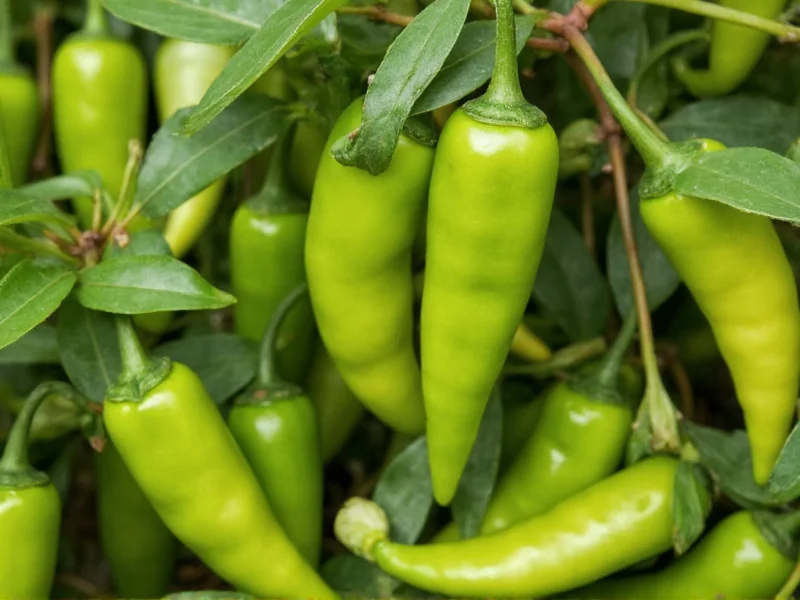The Scoville scale measures chili pepper heat by determining capsaicin concentration, and Hatch chiles demonstrate notable variability across their growing season and varieties. Originating from the Hatch Valley region of New Mexico, these celebrated green chiles earn their name from the agricultural community where they're predominantly cultivated. Understanding their precise heat range helps home cooks and professional chefs incorporate them appropriately into recipes without overwhelming heat.
Understanding Hatch Chile Varieties and Their Heat Levels
Hatch chiles aren't a single cultivar but rather a regional designation for New Mexico chiles grown in the Hatch Valley. The heat level varies significantly based on specific variety and maturity:
- Mild Hatch: 1,000-2,500 SHU - Perfect for those sensitive to spice
- Medium Hatch: 2,500-5,000 SHU - Most commonly available commercial variety
- Hot Hatch: 5,000-8,000 SHU - Contains noticeably more capsaicin
Unlike standardized commercial peppers, Hatch chiles' heat fluctuates based on growing conditions, soil composition, water availability, and sun exposure during the growing season. This natural variation contributes to their culinary appeal but requires caution when recipe planning.
Comparative Heat Analysis: Hatch Chiles on the Scoville Scale
Understanding where Hatch chiles fall on the Scoville scale provides valuable context for culinary applications. The following table compares Hatch varieties against other common peppers:
| Pepper Variety | Scoville Heat Units (SHU) | Heat Comparison to Hatch |
|---|---|---|
| Mild Hatch Chile | 1,000-2,500 | Baseline |
| Medium Hatch Chile | 2,500-5,000 | Most common variety |
| Hot Hatch Chile | 5,000-8,000 | Significantly spicier |
| Poblano Pepper | 1,000-2,000 | Slightly milder than mild Hatch |
| Jalapeño Pepper | 2,500-8,000 | Comparable to medium-hot Hatch |
| Serrano Pepper | 10,000-23,000 | 2-4x hotter than hot Hatch |
| Cayenne Pepper | 30,000-50,000 | 6-10x hotter than medium Hatch |
Factors Influencing Hatch Chile Heat Levels
Several environmental and biological factors affect the final heat measurement of Hatch chiles:
Growing Conditions Impact
Stressors like limited water, higher temperatures, and nutrient-deficient soil typically increase capsaicin production. The Hatch Valley's arid climate and mineral-rich soil contribute to the distinctive flavor profile and moderate heat levels that have made these chiles famous. During particularly dry growing seasons, even mild Hatch varieties may reach the upper end of their heat range.
Ripeness and Color Transformation
As Hatch chiles mature and change color from green to red, their heat profile evolves. Contrary to popular belief, red Hatch chiles aren't necessarily hotter than green ones of the same variety. The heat compounds change rather than increase, often resulting in a more complex flavor profile with slightly different heat characteristics. Red Hatch chiles typically develop more sweetness alongside their heat.
Harvest Timing Within Season
The Hatch chile season runs from late July through September, with early-season chiles generally milder than late-season varieties. As temperatures cool toward the end of summer, the plants produce chiles with more concentrated flavors and slightly higher heat levels. This seasonal variation explains why a medium Hatch purchased in August might feel noticeably different from one bought in September.
Culinary Applications Based on Heat Level
Understanding the hatch chile scoville rating helps determine appropriate culinary uses:
- Mild Hatch (1,000-2,500 SHU): Ideal for chile rellenos, sauces for children, and dishes where pepper flavor should dominate without significant heat. These work well in stuffed pepper recipes and as a base for green chile stew.
- Medium Hatch (2,500-5,000 SHU): The most versatile variety, perfect for traditional New Mexican dishes like posole, enchiladas, and carne adovada. This hatch green chile heat level provides noticeable warmth without overwhelming other flavors.
- Hot Hatch (5,000-8,000 SHU): Best for salsas, hot sauces, and dishes where pronounced heat is desired. These can substitute for jalapeños in recipes but deliver a more complex flavor profile. When using hot Hatch chiles, consider removing seeds and membranes to moderate the heat.
Common Misconceptions About Hatch Chile Heat
Several myths persist about hatch chile scoville measurements that deserve clarification:
Myth: All Hatch chiles are extremely hot
Reality: While some hot varieties exist, most commercially available Hatch chiles fall in the medium heat range. The "Hatch" designation refers to origin, not heat level.
Myth: Red Hatch chiles are always hotter than green
Reality: Color change indicates ripeness, not increased heat. The heat compounds transform rather than increase, often creating a different but not necessarily hotter experience.
Myth: Hatch chiles are a specific pepper variety
Reality: "Hatch" refers to the New Mexico region where various New Mexico chile varieties are grown. The same seed stock grown outside Hatch Valley isn't technically a Hatch chile.
Measuring Heat Perception Accurately
When working with hatch chile varieties heat levels, remember that Scoville ratings represent laboratory measurements, not individual taste experiences. Several factors influence perceived heat:
- Fat content: Capsaicin binds to fats, so creamy dishes like chile con queso reduce perceived heat
- Sugar content: Sweet ingredients counterbalance heat perception
- Acidity: Vinegar or citrus can heighten heat sensation
- Individual tolerance: Regular chili eaters develop higher heat thresholds
For precise heat control in cooking, remove seeds and white membranes (where most capsaicin concentrates) before using Hatch chiles. Roasting also transforms the heat compounds, often mellowing the final flavor profile while enhancing smoky notes.
Seasonal Availability and Heat Consistency
The Hatch chile season runs from late July through September, with peak availability in August. During this fresh season, heat levels vary based on the factors previously discussed. For year-round consistency, many chefs prefer frozen or canned Hatch chiles processed at peak season, which maintain more consistent heat levels than fresh chiles purchased later in the season.
When purchasing packaged Hatch products, check for heat level designations (mild, medium, hot) as these indicate the Scoville range. Products labeled simply "Hatch" without heat specification may vary significantly between batches.











 浙公网安备
33010002000092号
浙公网安备
33010002000092号 浙B2-20120091-4
浙B2-20120091-4